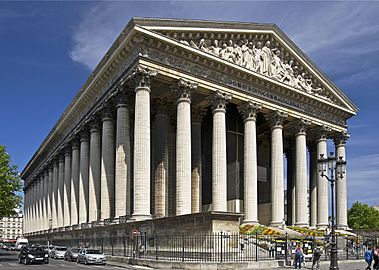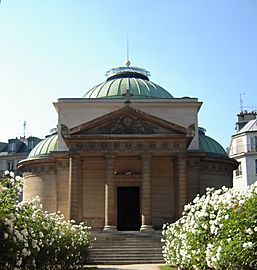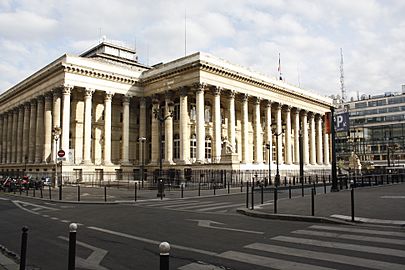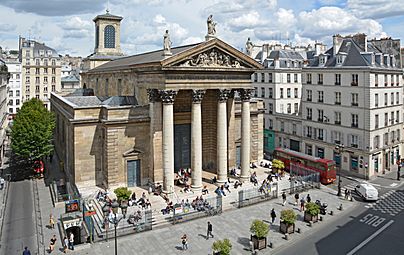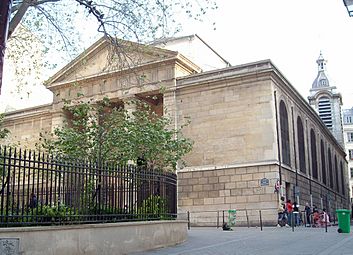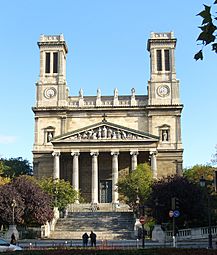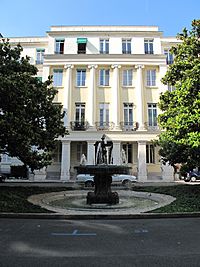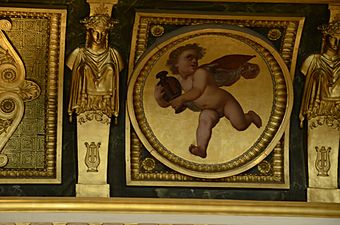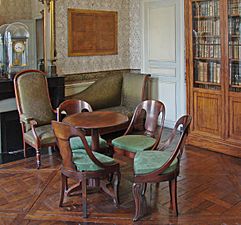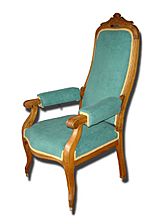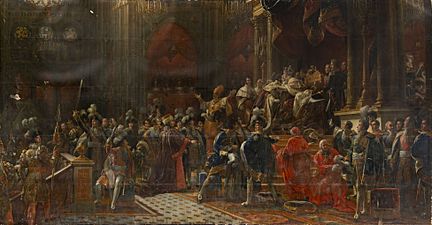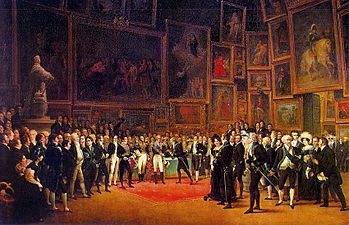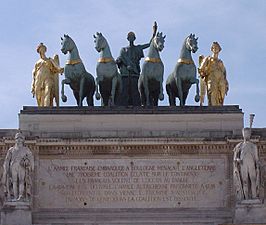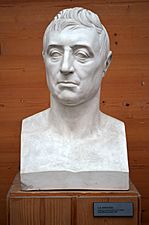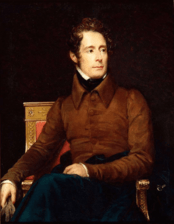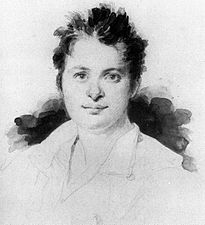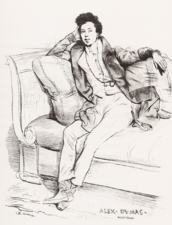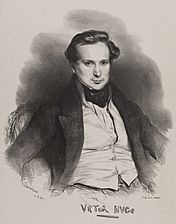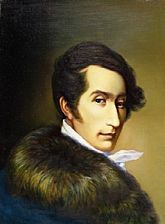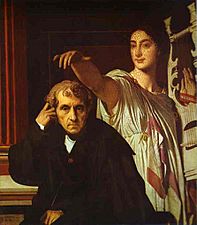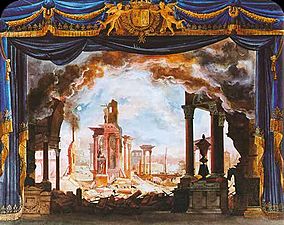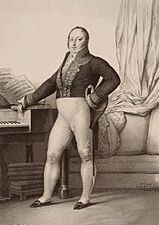French Restoration style facts for kids
The French Restoration style was a period in French art, architecture, and design. It happened between 1814 and 1830, when kings Louis XVIII and Charles X ruled France. This time started after Napoleon's fall and ended with the July Revolution of 1830. The style mostly followed Neoclassicism, which was inspired by ancient Greek and Roman art. But it also showed early signs of Romanticism, especially in music and books.
Contents
Architecture and Design
Public Buildings and Monuments
-
The Chapelle expiatoire (1826) by Pierre-François-Léonard Fontaine.
To remember Louis XVI and Marie Antoinette, King Louis XVIII built the Chapelle expiatoire. This chapel was built by Pierre-François-Léonard Fontaine in 1826. It stands where their bodies were first buried after they were executed.
The government brought back symbols of the old royal family. But they also kept building many projects started by Napoleon. For example, the church of La Madeleine was started before the French Revolution. Napoleon had turned it into a "Temple of Glory." During the Restoration, it became a church again. All new public buildings and churches from this time were built in the Neoclassical style.
Work slowly continued on the Arc de Triomphe, which Napoleon had started. The government planned to change it from a monument to Napoleon's wins to one celebrating a victory by the Duke of Angôuleme. But the work was not finished when the monarchy fell in 1830.
Other projects finished during this time included the Canal Saint-Martin in 1822. The Bourse de Paris, or stock market, was also completed in 1826. New storage buildings for grain, slaughterhouses, and markets were also built. Three new suspension bridges were put over the Seine River, but these were rebuilt later.
Religious Buildings
Several new churches were started during the Restoration. They replaced those destroyed during the French Revolution. Architects argued about whether to build in a neo-Gothic style, like Notre-Dame, or a Neoclassical style, like ancient Roman buildings. The Neoclassical style won out for most new churches until the 1850s.
Important Neoclassical architects of this time included Étienne-Hippolyte Godde. He finished Saint-Philippe de Role and Saint-Pierre-du-Gros-Caillou. He also built Notre-Dame-du-Bonne Nouvelle and Saint-Denys-du-Saint-Sacrament. Other famous architects were Louis-Hippolyte Lebas, who built Notre-Dame-de-Lorette, and Jacques Ignace Hittorff, who built the Church of Saint-Vincent-de-Paul. Hittorff later designed the Gare du Nord railway station.
Shopping Arcades
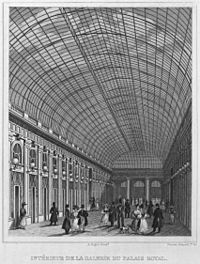
A new type of shopping area appeared in the late 1700s. These were called "passages" or "shopping galleries." They were rows of shops along a narrow street, covered by a glass roof. This was possible because of new ways to make glass and cast iron. People liked them because Paris streets often had no sidewalks. This meant walkers had to share space with wagons and crowds.
The first indoor shopping gallery in Paris opened in 1786 at the Palais-Royal. It had shops, cafes, and restaurants under its arches. More passages followed, like the Passage des Panoramas in 1800. In 1834, architect Pierre-François-Léonard Fontaine covered a whole courtyard at the Palais-Royal with a glass roof. This was called the Galerie d'Orleans. It was an early example of the glass roofs seen in later Paris department stores.
Homes and Houses
During the Restoration, new neighborhoods were built in Paris, especially to the north and west. This happened as the city grew. Between 1824 and 1826, new areas like Saint-Vincent-de-Paul and Passy were planned. Houses were built on wider plots of land.
A typical new home was four to five stories tall. It had a sloping attic roof with many windows. The style was simpler, with more horizontal lines. Large windows and decorative iron balconies were common. This style became standard for Paris buildings until the mid-1800s.
Large private homes, called hôtel particular, were often built in a Neoclassical style. This style was based on Greek architecture or the work of Palladio. The Square d'Orleans was a private residential area built in an English Neoclassical style. Famous people like George Sand and Frédéric Chopin lived there. Some homes in the new areas also started to mix Renaissance and classical styles. This was called the Troubadour style. It showed a move away from strict Neoclassicism towards more varied home designs.
Inside Homes and Furniture
-
Decoration at the Musée Charles X, the Louvre.
-
Ceiling decoration at the Musée Charles X, the Louvre.
-
The study room of Auguste Comte, showing a Voltaire armchair.
The interior design of the French Restoration mixed different styles. It took geometric shapes from Neoclassicism and rich decorations from the Louis XIV era. It also used colors from the Renaissance. A great example is the Charles X museum inside the Louvre. Its rooms were used for art shows. Ceilings were divided into sections with paintings and decorated with columns.
Neo-Gothic styles also started to appear in interior design in the 1820s. This included arches and rose windows, like those in Gothic cathedrals. Another feature was polychromy, which means using bright colors in decorations. This was done with colored stone, glass, or paintings. Ceilings were often very fancy, with domes and decorative paintings.
The inside of the Chapelle expiatoire is another example. While the building looks simple and Neoclassical from the outside, the inside of the dome is covered with rosettes. There are also many detailed sculptures below the cornices and between the columns. These include Maltese crosses, fleur-de-lis, and roses. The floor also has colorful stone designs with the same patterns.
After Napoleon's fall, many rich families who had left France during the Revolution came back. They found their furniture was gone. King Louis XVIII liked the Empire style, so furniture stayed similar but without Napoleon's symbols. When Charles X became king in 1824, he gave money to these families. This helped the luxury furniture industry grow again. People became interested in older styles like Gothic and Renaissance. The Gothic revival became very popular after Victor Hugo's book The Hunchback of Notre-Dame was published in 1831.
Gilded bronze decorations became less common. Instead, furniture often had marquetry inlay. This meant using different colored woods to create detailed floral designs. Under Charles X, the "Cathedral chair" became popular. Its back looked like a Gothic stained glass window. The Gothic rose and other floral designs were also popular on furniture.
Comfort became important for new chairs. The Voltaire armchair became very popular. It had curved front legs, a high padded back, and padded armrests. It was named after a famous picture of Voltaire sitting in a similar chair.
Painting
-
Coronation of Charles X of France by François Gérard (around 1827).
The Restoration period saw the start of a big artistic debate between Neoclassicism and Romanticism. Jacques-Louis David, a leading Neoclassical painter, left France. But his students stayed and continued his style, just changing their subjects. François Gérard painted the coronation of King Charles X in 1827, similar to David's painting of Napoleon's coronation. Other students of David included Antoine-Jean Gros and Jean-Auguste-Dominique Ingres. Ingres painted his famous Grand Odalisque around this time.
The new Neoclassical painters, like Ingres and Gérard, focused on making perfect human figures. They paid attention to lines, composition, and color. Ingres painted a large mural for the Louvre called Apothéose de Homer (The Apotheosis of Homer) in 1827. It showed famous artists from history honoring Homer. Ingres was also a top portrait painter of his time. His painting Roger rescuing Angelique (1819) had a dream-like feel, hinting at later dramatic art. Other painters who used a softer Neoclassical style included Pierre-Paul Prud'hon and Élisabeth Vigée Le Brun.
Jean Louis Théodore Géricault took a different approach with his painting The Raft of the Meduse (1818–1819). It showed the real story of shipwreck survivors on a raft, trying to get help. Géricault carefully studied human bodies to make the painting very realistic. This painting caused a lot of debate. Géricault also painted "The Tempest" (1821–24), showing how helpless humans are against nature. His style became known as "theatrical romanticism."
Eugène Delacroix was another important painter of "theatrical romanticism." He was inspired by artists like Rubens and Goya. After visiting England, he became friends with writers like Stendhal and Victor Hugo. In 1828, he showed The Death of Sardanapale. After the July Revolution in 1830, he painted Liberty Leading the People. This painting became a famous symbol of French art.
Sculpture
-
Bust of the Marquis de Lafayette by David d'Angers (1828).
The most famous French sculptor during the Restoration was François Joseph Bosio (1768-1845). He studied in Paris and later sculpted for Napoleon's family. During the Restoration, he became the king's sculptor. He made portraits and sculptures in a classical-romantic style. He created the main statue of Louis XVI for the Expiatory Chapel.
In 1828, Bosio finished a new sculpture for the top of the Arc de Triomphe du Carrousel. Napoleon had taken a chariot sculpture from Venice for it, but it was returned. The new kings asked Bosio to make a new one called "Peace guiding a Chariot." Bosio also replaced the equestrian (horseback) statue of Louis XIV in Place des Victoires, which had been destroyed during the Revolution. His new, tall version was put up in 1828.
Another important sculptor was Pierre Jean David (1788–1856), who called himself David d'Angers. He studied with Jacques Louis David and later in Rome. He focused on showing patriotic and moral values in his work. He made busts or statues of many famous people, including the Marquis de Lafayette and Thomas Jefferson. In 1830, he started his most famous work, a large sculpture above the entrance of the Pantheon.
François Rude (1784–1847) also began his career during this time. He won the Prix de Rome, a famous art prize. He was a supporter of Napoleon, so he lived in Belgium after Napoleon's fall. He returned in 1827. Between 1833 and 1836, he created the famous sculptures called Les Marseillaise on the Arc de Triomphe.
Literature and Theater
-
François-René de Chateaubriand (1828).
-
Drawing of Honoré de Balzac in the 1820s.
-
Alexandre Dumas by Achille Devéria (1829).
-
Victor Hugo in 1829.
The Bourbon Restoration saw romanticism become the main style in French literature. One of the first important romantic writers was François-René de Chateaubriand. He was an essayist and diplomat. He started as a strong supporter of the king and the church. But he slowly became a liberal and believed strongly in freedom of speech. Other important romantic writers included the poet Alphonse de Lamartine, Gérard de Nerval, Alfred de Musset, Théophile Gautier, and Prosper Mérimée.
Even with limits on press freedom, Paris publishers released the first works of some of France's most famous writers. Honoré de Balzac moved to Paris in 1814. He published his first novel, Les Chouans, in 1829. Alexandre Dumas moved to Paris in 1822. He published his first play, Henri III and his Courts, in 1829. Stendhal, a pioneer of realistic writing, published his first novel, The Red and the Black, in 1830.
The young Victor Hugo wanted to be as great as Chateaubriand. His first book of poems in 1822 won him a prize from King Louis XVIII. His second book in 1826 made him a leading poet. He wrote his first plays, Cromwell and Hernani, in 1827 and 1830. His first short novel, The Last Days of a Condemned Man, came out in 1829. The first showing of his very romantic play Hernani caused a big commotion in the audience, just before the monarchy fell.
Music
The return of the monarchy ended the huge outdoor celebrations with patriotic music from Napoleon's time. Music moved back to the private homes of the rich families. The Paris Music Conservatory was renamed the Royal School of Music. The king asked Luigi Cherubini to write music for Louis XVI and for his own coronation. Gaspare Spontini became the director of royal music. A royal group for religious music was also started in 1825. It performed old French religious music that had been banned or ignored.
-
Carl Maria von Weber (1825).
-
Portrait of Luigi Cherubini by Ingres (1842).
-
Set for The Siege of Corinth by Gioachino Rossini (1826).
-
Lithograph of Gioachino Rossini in 1829.
Composers like Gluck were popular early in this period. But new composers soon appeared. Carl Maria von Weber came from Germany. He put on a very successful French version of the first romantic German opera, Der Freischütz, in 1824.
The most successful musical theater was the Théâtre-Italien. It showed operas by the famous composer Gioachino Rossini, including The Barber of Seville in 1819. Rossini moved to Paris in 1824 and became the director of music there. Only Italian operas were performed, always in Italian. Rossini became a leading figure in Paris music. He wrote music for Charles X's coronation in 1824.
In 1820, a supporter of Napoleon killed the Duke du Berry at the Paris opera house. King Louis XVIII ordered the opera house to be closed and torn down. The Opera moved to the Salle Le Peletier. This theater saw the birth of the first French grand opera and romantic opera. This was La Muette de Portici by Auber in July 1829. This opera's story, about people rebelling against Spanish rule, was very romantic and revolutionary. A performance of this opera in Brussels in 1830 even led to riots and a real revolution.
The Paris opera continued to amaze audiences with new musical and visual effects. For the opera The Last Days of Pompeii, the opera used the scientist Louis Daguerre. He created optical illusions on a screen, making it look like dancing flames and sea waves.
To meet the demand for grand opera, Rossini was asked to write Le siège de Corinthe and then William Tell. William Tell premiered in 1829. Despite its famous opening music, critics found it too long and lacking action. This criticism made Rossini stop writing operas at age 37.
Working-class people in Paris also had musical clubs called goguettes. These clubs were for both men and women. They usually met once a week, often in the back room of a bar. They would sing popular, funny, and emotional songs. During the Restoration, songs were also a way to express political views. The poet and songwriter Pierre-Jean de Béranger became famous for songs that made fun of the rich, the church, and the government. He was jailed twice for his songs, which only made him more famous. The Paris police chief Eugène François Vidocq sent his men to join the goguettes and arrest those who sang songs against the king.


